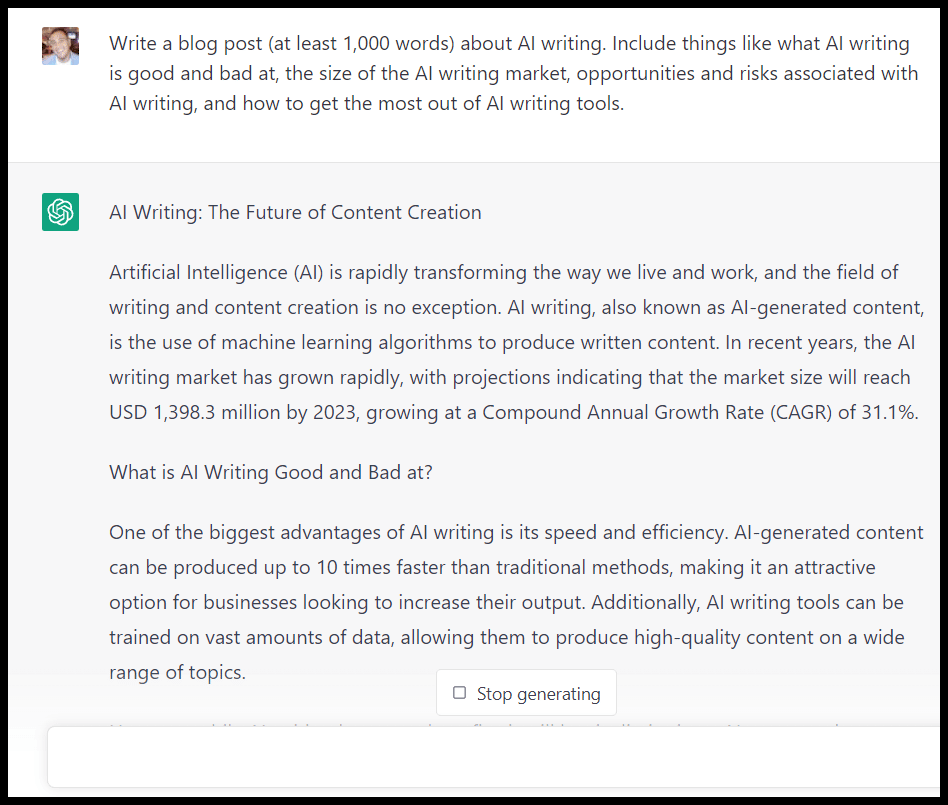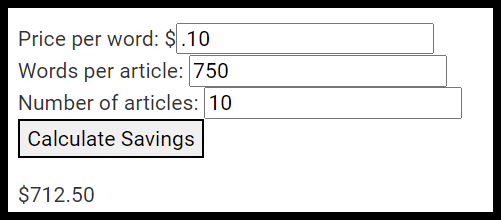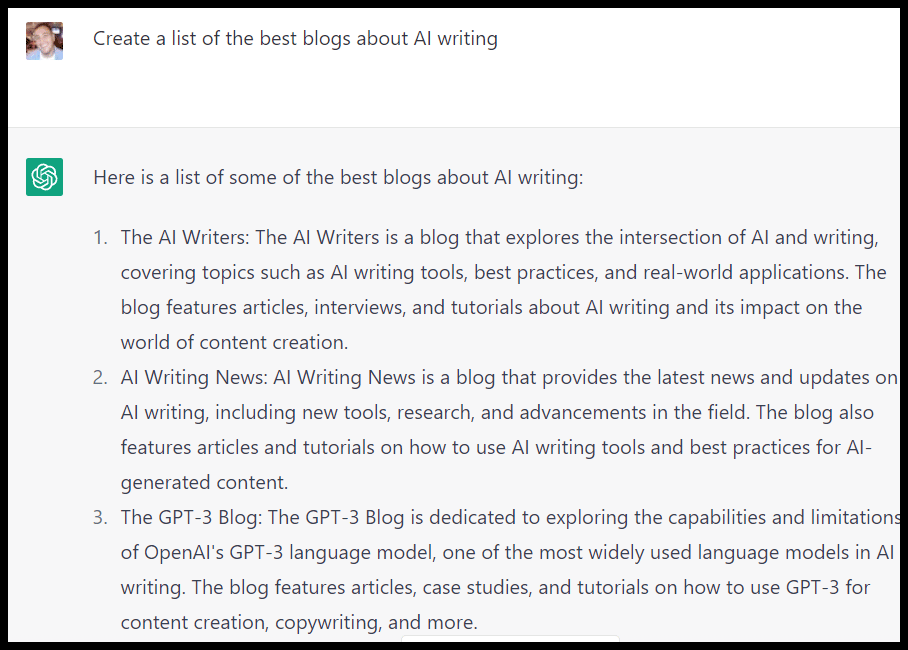
How ChatGPT can help you create content for SEO
[ad_1]
ChatGPT is top of mind for many people in the content creation and SEO spaces – and even seems to be a developing obsession inspiration to Google itself.
The biggest question for SEOs and people trying to create content to drive traffic from search engines is obviously:
How can ChatGPT help create content for SEO?
ChatGPT performs a few specific functions that can help you with content creation for SEO like:
- Writing whole SEO-focused blog posts, articles, and landing pages.
- Generating research you can use in SEO-focused content.
- Performing specific SEO tasks to support your content creation, like keyword research or content clustering.
- Creating embeddable elements and enhancements within your content to make the articles better and more linkable.
Sounds good, right?
The flip side is that while ChatGPT can be incredibly useful in some SEO content creation scenarios, it can also introduce risks for your sites. (Not to mention, it is still quite bad at several tasks.)
This article will walk you through some functions you can use to help you create content for SEO, alert you to some of the risks associated with some of them and discuss the areas where you might be better suited to use a different tool for the job.
Contents
- Writing blog posts with ChatGPT
- Creating subsections, meta descriptions and short content blocks
- Creating outlines of blog posts
- Lists of stats
- Rewriting and editing content
- Creating data visualizations and infographics
- Content clustering and keyword research
- Outreach assistant
- Get creative and master your prompts
Writing blog posts with ChatGPT
ChatGPT can write entire blog posts in a few minutes (and is not super humble about it if the output it generated is any indication):

Google has said their primary concern is whether AI content is “helpful” and that all their guidelines and recent updates (including E-E-A-T) will apply to AI content.
They recently wrote about this again, explicitly saying there is no “ban” on AI-generated content in Google search results.
As with many things in SEO, if your question is “does AI content work” the answer is really “it depends.”
If you have a very authoritative site like Bankrate or CNET, there might be a class of topics where AI content can rank very well, potentially even with minimal editing.
If you’re an independent publisher cranking out thousands of AI-generated blog posts, or you’re just a less authoritative site pushing out lots of AI content, you may not be so lucky (see Mark Williams-Cook’s example in the first comment here):
As you can see his graph was moving up and to the right for a while (until it wasn’t).
If you’re running a business, you also have to worry about the accuracy of ChatGPT’s content, as you would with in-house or freelance writers.
There are many things that it just gets wrong, as the tool itself will admit:

So whether you can run with intact ChatGPT content is a question of what you’re trying to accomplish and your risk threshold.
Creating subsections, meta descriptions and short content blocks
While you want to be careful with the amount of content you let ChatGPT run wild on, you can do a few things to make the content it produces more useful:
- Specific prompts: Give very specific prompts about the angle you want the tool to take.
- Training data: Feed it a paragraph from your writing or a writer you want it to emulate to improve the writing style.
- Limit volume: By limiting the amount of content you’re expecting you can be more likely to get the right output
Instead of asking ChatGPT to run off and write an entire article, we can give it a paragraph from our writing and then ask it to write something highly specific to create a usable paragraph:

Additional things you can task ChatGPT with along these lines include:
- Product descriptions: This is once you feed the basic information about the product. Remember, ChatGPT can’t crawl the web and give you info about a product, and the information it does have may be outdated.
- Content or source summaries: You can summarize (and link to) a blog post, research paper, etc.
- Sources and resources: You can ask ChatGPT to create a list of books your readers would like or a list of great sources (although again be careful to vet any web-based sources the tool is generating for you).
Creating outlines of blog posts

Now we may be getting closer to a relatively safe function for ChatGPT, more of a writing assistant than an author of whole articles.
If you’re creating SEO-focused content, this won’t perform the function of tools like Clearscope, Market Muse, Content Harmony or similar which generate content briefs and outlines focused specifically on optimizing the article for search rankings.
That said, having ChatGPT generate an outline can give you some good ideas and jumpstart your article drafts.
Lists of stats

Again it’s important to stress that the information you get from AI tools like ChatGPT can frequently be wrong or misleading, but you can use the tool as a research assistant to quickly generate a big list of stats for you.
Rewriting and editing content
As you’ve already seen above ChatGPT lets some inaccuracies slip through and may not be replacing thorough human editors any time soon, but the tool can help clean up certain elements in your article.
Some examples are below.
Shortening paragraphs
If you’re looking to stick to short paragraphs and edit content to be more scannable, you can ask ChatGPT to break up your paragraphs for you:

Adding subheadings to an article
To further improve your article’s scannability, you can also have ChatGPT create sub-headings for your content. You have to be very specific in your prompts here, or you’ll end up with just an outline.
Here is the prompt that worked for me:

Focusing your content
You can also ask the tool to better focus your first paragraph on what a searcher is looking for to help with engagement when a visitor first lands on a page:

Get the daily newsletter search marketers rely on.
I was very excited about using ChatGPT to generate code for me. People are allegedly using the tool to take on work as a developer, so I thought it would be a great opportunity to build free tools to help improve content quality and engagement and to use in link outreach.
I tried creating a free calculator widget starting with a super simple prompt:

I grabbed the initial code output and put it right into a blog post, and the output was pretty promising.

Not very pretty and the math is obviously wrong, but it’s a start. Next, I added another prompt:

And had another update with some improvements.

I had to play with additional prompts to tweak the background and get the calculation right, but here is the final version.

You can test the tool with different inputs live on our site here.
With enough patience, there are likely different kinds of widgets you could get ChatGPT to build for you, like:
- Forms.
- Simple applications.
- Tables.
- Simple plugins.
You may be able to have it clean up code or troubleshoot issues with code that’s already written as well.
Creating data visualizations and infographics
Like with lists of stats, you can delegate digging up relevant statistics to ChatGPT and then use those in an infographic.
I thought it might be interesting to see if ChatGPT could help me create a graphic using its sister tool DALL-E (kind of like that time Google Home talked to Alexa), and asked it for a prompt:

Unfortunately, DALL-E currently seems to be unable to render English text in images:

(And Canva’s image AI tool had similar issues, so for the time being you’ll need to port your data over to a tool and create the infographic manually.)
Content clustering and keyword research
If you have your own process for creating topic clusters and researching keywords based on SEO-focused data, you may not want to rely on ChatGPT for these tasks entirely.
That said you can use the tool for brainstorming:

To get more keyword ideas from different angles, try asking:
- For a glossary of terms related to your topic.
- For high-level concepts related to your topic.
- For categories related to your niche or subtopics related to your topic.
- Questions a person interested in your niche would ask.
You can also ask the tool for “popularity scores” for terms, but as ChatGPT will tell you it can’t access current search data so be sure to cross-check with your favorite keyword tool.
And can also use it to break out lists of terms into simple clusters:

You can also try different groupings like clustering by intent or terms containing the same words.
Keep in mind that currently, you can only input 4,096 characters into the ChatGPT chatbox. There’s a limit to how many terms you can submit to be clustered, and again these won’t be clustered based on any SEO-focused data.
Outreach assistant
In addition to your content creation efforts, ChatGPT can help you with various content promotion tasks. You can use the tool to create a list of blog posts:

And it can even come up with blog topics for specific sites and write your outreach emails.
Again, remember that the data the tool is trained on isn’t up to date, so some of the ideas it generates may be things the blog has written about since training data was collected for ChatGPT.
Get creative and master your prompts
In this article, we’ve run through some general areas where ChatGPT can help with content creation for SEO. As the platform improves, the list will continually grow as well.
A good approach is to think about the things that ChatGPT is good at (and the things that it’s not) and how those can help you in your day-to-day efforts.
I try to think of ChatGPT more as a writing and research assistant than an “AI content creator.”
With that mindset, think of using the tool as if creating an SOP or delegating a task to a person. You have to:
- Make sure the task is fit for the person’s skill set.
- Describe what you want clearly.
- Clarify what exactly you want if what you get back isn’t what you expected.
AI is becoming an increasingly important part of many marketing toolsets. Lots of tools content creators use frequently like Canva, Notion, and others have added AI tools into their offerings.
As such, getting more familiar with how prompts work – including the types of prompts that AI tools struggle with and how to get a task back on the rails after your prompt has returned an output you didn’t want – is vital for a more efficient AI-powered content creation process.
Opinions expressed in this article are those of the guest author and not necessarily Search Engine Land. Staff authors are listed here.
[ad_2]
Source link




